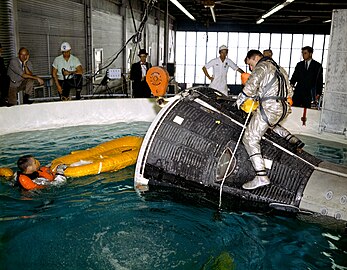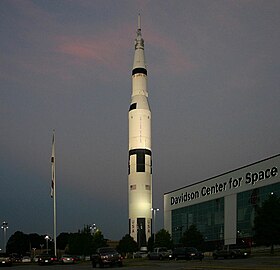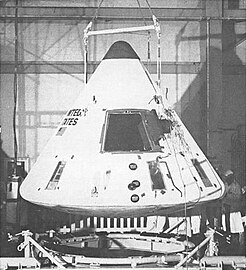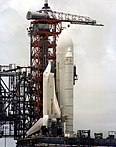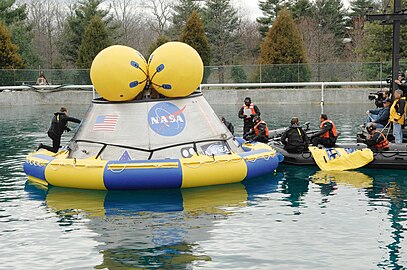Boilerplate (spaceflight)

A boilerplate spacecraft, also known as a mass simulator, is a nonfunctional craft or payload that is used to test various configurations and basic size, load, and handling characteristics of rocket launch vehicles. It is far less expensive to build multiple, full-scale, non-functional boilerplate spacecraft than it is to develop the full system (design, test, redesign, and launch). In this way, boilerplate spacecraft allow components and aspects of cutting-edge aerospace projects to be tested while detailed contracts for the final project are being negotiated. These tests may be used to develop procedures for mating a spacecraft to its launch vehicle, emergency access and egress, maintenance support activities, and various transportation processes.
Boilerplate spacecraft are most commonly used to test crewed spacecraft; for example, in the early 1960s,
Mercury boilerplates
Mercury boilerplates were manufactured "in-house" by
Etymology
The term boilerplate originated from the use of
Notable events
- 1959 July 22 – First successful pad abort flight test with a functional escape tower attached to a Mercury boilerplate.
- 1959 July 28 – A Mercury boilerplate with instrumentation to measure sound pressure levels and vibrations from the Little Joe test rocket and Grand Central abort rocket/escape tower.
- 1959 September 9 – A Big Joe Atlas boilerplate Mercury (BJ-1) was successfully launched and flown from Cape Canaveral. This test flight was to determine the performance of the heat shield and heat transfer to the boilerplate, to observe flight dynamics of boilerplate during re-entry into the South Atlantic, to perform and evaluate capsule flotation and recovery system procedures, and to evaluate the entire capsule and rocket characters and system controls.[6]
- 1960 May 9 – Beach Abort test with a launch escape system was successful.
- 1961 February 25 – A successful drop test of the Mercury boilerplate spacecraft fitted with impact skirt, straps and cables, and a heat shield.[7]
- 1961 March 24 – A successful Mercury-Redstone BD (MR-3) launched occurred with an apogee of 181 km (112 mi); first sub-orbital uncrewed flight.[7]
Photos
-
Mercury Beach Abort test
-
Mercury parachute test
-
Mercury flotation test
Gemini boilerplates
There were seven Gemini boilerplates: BP-1, 2, 3, 3A, 4, 5, and 201.[8] Boilerplate 3A had functional doors and had multi-uses for testing watertightness, flotation collars, and egress procedures.[citation needed]
Photos
Apollo boilerplates
NASA created a variety of Apollo boilerplates.[9]
Launch escape system tests (LES)
Apollo boilerplate command modules were used for tests of the launch escape system (LES) jettison tower rockets and procedures:
- BP-6 with Pad Abort Test-1 – LES pad abort test from launch pad; with photo.[citation needed]
- BP-23A with Pad Abort Test-2 – LES pad abort test of near Block-I CM; with photo.[citation needed]
- BP-23 with Mission A-002 Test Flight – LES test of canards, Oct. 29-Nov. 5, 1964.[10]
- BP-27 with LES-015 – Dynamic tests.[11]
Boilerplate tests
- BP-1 – Water impact tests[11]
- BP-2 – Flotation tests storage[11]
- BP-3 – Parachute tests[11]
- BP-6,-6B, – PA-1, later parachute drop test vehicle,[11] and LES pad abort flight test to demonstrate launch escape system's pad-abort performance at White Sands Missile Range.[12]
- BP-9 with mission AS-105 (SA-10) test flight, Micro Meteoroid Dynamic Test; not recovered.[11]
- BP-12 with mission A-001 test flight, now at former NASA Facility, Downey, CA[10] to test the LES transonic abort flight performance at White Sands Missile Range.[12]
- BP-13 with mission AS-101 (SA-6) test flight, not recovered.[11]
- BP-14 with environmental control system tests, Oct. 22–29, 1964,[10] consisted of command module 14, service module 3, launch escape system 14, and Saturn launch adapters.[11]
- BP-15 with mission AS-102 (SA-7) test flight, not recovered.[11]
- BP-16 with mission AS-103 (SA-9) test flight, another Micro Meteoroid test, not recovered.[11]
- BP-19A –
- BP-22 with mission A-003 test flight; boilerplate on display at Johnson Space Center, Houston, TX[14]
- BP-23 – LES high-dynamic-pressure abort flight performance tests at White Sands Missile Range.[12]
- BP-23A – LES pad-abort flight performance tests with Canard, BPC, and major sequencing changes at White Sands Missile Range,
- BP-25 Command Module (CM) – Water recovery test, at Fort Worth Museum of Transportation[11](See BP-25 photo)
- BP-26 with mission AS-104 (SA-8) test flight – another micro meterioid test.[11]
- BP-27 command and service module with LES-16 – stack and engine gimbal test.[11] Now on display atop the vertical Saturn V at the U.S. Space & Rocket Center, Huntsville, Alabama.[15]
- BP-28A – Impact tests[11]
- BP-29 – Uprighting drop tests at
- BP-30 – Swing arm tests; currently on display at Kennedy Space Center's Apollo/Saturn V Center.[11]
Specific Apollo BP units
BP-1101A
BP-1101A was used in numerous tests to develop spacecraft recovery equipment and procedures. Specifically, 1101A tested the air bags as part of the uprighting procedure when the Apollo lands upside down in the water. The sequence of the bags inflating caused the capsule to roll and upright itself.[16]
This McDonnell boilerplate is now on loan to the Wings Over the Rockies Air and Space Museum,[17] Denver, Colorado, from the Smithsonian. BP-1101A has an external painted marking of AP.5. Examination of the interior in 2006 revealed large heavy steel ingots.[18] After further research, a new paint scheme was applied in June 2007.
-
BP1101A AP5, front view, Wings Museum, 2006
-
BP1101A AP5, side view
-
New paint scheme, June 2007
BP-1102A
BP-1102 was used for water egress trainer for all Apollo flights, including by the crew of Apollo 11, the first lunar landing mission. It was also adapted for mock-up interior components and used by astronauts to practice routine and emergency exits from the spacecraft.[citation needed]
It was then modified again where the interior was set up to be configured either as Apollo/Soyuz or a proposed five-person
BP-1210


BP-1210 was used in landing and recovery training and to test flotation devices. It is on display outside the Stafford Air & Space Museum.[20]
BP-1220/1228 Series
The purpose of this series design was to simulate the weight and other external physical characteristics of the
BP-1224
BP-1224 was a component-level flammability-test program to test for design decisions on selection and application of non-metallic materials. Boilerplate configuration comparisons with command and service module 2TV-1 and 101 were performed by North American. The NASA review board decided on February 5, 1967, that the boilerplate configuration had determined a reasonable "worst case" configuration, after more than 1,000 tests were performed.[22] See BP-1224 photo set.
BP-1227
Details regarding this test capsule are not clear, but most likely it was lost at sea somewhere between the
See BP-1227 photo. The only certainties about this capsule are that it was returned to the United States at Murmansk early in September 1970 during a visit by the USCG Southwind who returned it to the Naval Air Station, Norfolk, Virginia. There it remained until title was passed to the Smithsonian in April 1976 when it was passed on to Grand Rapids, Michigan to serve as a time capsule. Two official sources – the US Navy and the US Coastguard – both say that it was lost by an ARRS (Aerospace Rescue and Recovery Squadron) unit training in recovery procedures. A contemporary account of its return quotes a NASA spokesman as saying, " ... as far as NASA can determine the object... the Navy lost two years ago."Apollo Lunar Module
A Lunar Module (LM) boilerplate, the LM test article, was launched with Apollo 8 to simulate the correct weight and balance of the LM which was not ready for the flight.
Space Shuttle boilerplates
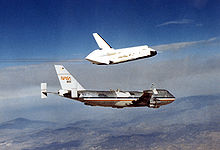
Left - Enterprise is lowered into the Dynamic Structural Test Facility for the Mated Ground Vibration Tests
Center - Enterprise is mated with ET and SRBs to undertake fit-check tests at KSC Pad 39A
Right - Enterprise with ET and SRBs in fit-check tests at SLC-6
As part of the Space Shuttle program, a number of boilerplate vehicles were constructed using various materials to undertake key tests of procedures, infrastructure and other elements that would take place during a Shuttle mission.
Facilities Test Article
In 1977, the Marshall Space Flight Center (MSFC) constructed a simple steel and wood orbiter mockup to be used in fit check activities for various elements of the infrastructure needed to support the Space Shuttle, including roadway clearances and crane capabilities, as well as for testing in various buildings and structures used as part of the program, both at the MSFC and at the Kennedy Space Center. The mockup was designed to be the approximate size, shape and weight of an actual orbiter, and allowed these initial tests to be undertaken without using the far more expensive and delicate prototype orbiter, Enterprise.[30] Following its use as a test article, the mockup was stored until 1983, when it was refurbished and modified to more closely resemble an actual orbiter, before being displayed in Tokyo.[31]
Structural Test Article
The Structural Test Article was built as a test vehicle intended for use in initial vibration testing to simulate entire flights.[32] The STA was built as essentially a complete orbiter airframe, but with a mockup of the crew compartment installed, and the thermal insulation only fitted to the forward fuselage.[33] The simulation testing of the STA was undertaken over the course of eleven months following its rollout in February 1978; at the time, it was intended that the prototype orbiter Enterprise would be converted into a full flight ready model, but the cost of undertaking this work, along with a number of design changes that had taken place between Enterprise being rolled out, and the final construction of the first operational orbiter, Columbia, meant that it was decided instead to upgrade the STA into a flight model. This began following the end of the STA testing in January 1979, with the completed orbiter, named as Challenger, rolled out in June 1982.[32]
Prototype
Approach and landing tests
In January 1977, the prototype orbiter Enterprise was delivered to Edwards Air Force Base in California for the beginning of its overall test programme, which would encompass flight tests, fit-check and procedures testing of the orbiter, its systems, the facilities and procedures required to launch, fly and land the spacecraft safely. During 1977, Enterprise was used in what was called the Approach and Landing Tests programme of testing, which encompassed mating the orbiter to the Shuttle Carrier Aircraft, a modified Boeing 747 to test the taxiing and flight characteristics of the Orbiter / SCA combination. This included flights of the combination in which Enterprise itself was powered up and crewed, to test crew procedures systems in flight, and finally a set of five so-called "free-flights", with Enterprise jettisoned from the SCA at altitude to land on its own, testing the orbiter's own flying and handling characteristics.[34]
Vibration and fit-check tests
In March 1978, following its use in flight tests during the ALT program, Enterprise was taken to the MSFC in Huntsville, Alabama for use in the Mated Vertical Ground Vibration Test. This would see Enterprise mated to an empty External Tank and dummy Solid Rocket Boosters, creating a boilerplate version of the complete Space Shuttle stack for the first time. Inside the Dynamic Structural Test Facility at the MSFC, the stack was subjected to a series of vibration tests simulating the various stages that it would be subjected to during launch.[35]
Following its use at Huntsville, Enterprise was then taken to the
Orion boilerplate
This section's factual accuracy may be compromised due to out-of-date information. (July 2011) |
Development
The construction of the first Orion boilerplate,
Other boilerplates would be used to test thermal, electromagnetic, audio, mechanical vibration conditions and research studies. These tests for the Orion spacecraft would be done at Plum Brook Station in the agency's Ohio-based Glenn Research Center.[42][43]
Photos
Commercial spacecraft boilerplates
This section needs expansion. You can help by adding to it. (May 2013) |
In the 2010s, several commercially designed space capsules used boilerplate units on the initial launches of new launch vehicles.
- The Dragon spacecraft.[44]
- The Cygnus Mass Simulator was a boilerplate capsule launched to orbit on the maiden flight of the Orbital Sciences Corporation Antares rocket on April 21, 2013. It was built to outer mold line and mass distribution of the Cygnus spacecraft.[45][46]
- On the
See also
- Project Mercury
- Project Gemini
- Project Apollo
- Battleship (rocketry)
- Rendezvous Docking Simulator
- Space Shuttle Pathfinder
- Orion Abort Test Booster
Notes
- ^ NASA Mercury History Archived January 27, 2007, at the Wayback Machine Sections #44 and #47
- ^ Mercury Project Boilerplates Archived November 7, 2007, at the Wayback Machine and Little Joe Rockets with Boilerplates Archived August 2, 2007, at the Wayback Machine
- sheet steel typically used to manufacture boilers
- ^ Mercury Boilerplate Tests
- ^ NASA History Archives
- ^ NASA History Chronology
- ^ a b Astronautix Chronology – Quarter 1 1961 at Encyclopedia Astronautica
- ^ Field Guide to American Spacecraft
- ^ "Apollo BP-19 Boilerplate Spacecraft Test Unit". www.skytamer.com. Retrieved 2023-09-15.
- ^ a b c d "NASA History Apollo". Archived from the original on 2007-08-10. Retrieved 2007-06-05.
- ^ a b c d e f g h i j k l m n o p q r LJSC: Apollo/SkylabB ASTP and Shuttle Orbiter Major End Items, Final Report, March, 1978
- ^ a b c d NASA Apollo History Vol. IV
- ^ "Long Beach Press Telegram article 7/16/2008". Archived from the original on 2011-06-13. Retrieved 2008-07-22.
- ^ Little Joe II Mission A-003 / BP-22 – April 1965 (PDF)
- ^ "Saturn V". U.S. Space & Rocket Center. February 14, 2008. Retrieved February 13, 2011.
- ^ Charles A. Biggs Sr., Chief, Special Activities Section, Special Event Office, Johnson Space Center, Houston, TX, letter dated July 1, 1975. Files of Wings Museum, Denver, CO.
- ^ Wings Over the Rockies Air & Space Museum Official Site
- ^ Lance Barber, Curator of Military Aircraft, Wings Over the Rockies Air & Space Museum, Denver, CO.
- ^ Smithsonian NASM: Apollo Boilerplate Archived April 8, 2010, at the Wayback Machine
- ^ Stafford Museum exhibits\
- ^ Smithsonian National Air and Space Museum BP-1228 Photo. Archived December 10, 2006, at the Wayback Machine
- ^ NASA: Apollo BP-1224
- ^ "USCGC Southwind, 1944 WAG/ WAGB-280 (ex-Admiral Makarov; ex-Atka)". United States Coast Guard Historian's Office. U.S. Department of Homeland Security DHS Office of Inspector General. February 27, 2014. Retrieved July 14, 2015.
- ^ Pugh, Eddie. "NASA's Lost Boilerplate – The Story of BP-1227" (PDF). Jones site. Landing and Recovery Division – Gemini and Apollo Programs. Retrieved July 14, 2015.
- ^ "Modern History: Soviets Recovered an Apollo Capsule!". All Empires Online History Community. Web Wiz. August 30, 2005. Retrieved July 14, 2015.
- ^ Ермолаев, Дмитрий (February 28, 2015). "Космический улов" [Space catch]. Мурманский вестник (in Russian). Russia. Retrieved August 4, 2019.
- ^ Wade, Mark (2008). "Soviets Recovered an Apollo Capsule!". Astronautix. Archived from the original on January 2, 2010. Retrieved January 8, 2010.
- ^ Current Location
- ^ "Apollo/Skylab ASTP and Shuttle orbiter major end items" (PDF) (Press release). NASA JSC. March 1978. p. 20. Retrieved 2019-08-15.
- ^ Kesner, Kenneth (June 12, 2008). "Shuttle mockup undergoes repairs". The Huntsville Times. Archived from the original on December 4, 2011. Retrieved July 6, 2011.
- ISBN 978-1857801163.
- ^ a b Lardas, Mark (2012). Space Shuttle Launch System: 1972–2004. Osprey Publishing. p. 36.
- ISBN 978-0-387-46355-1.
- ^ Merlin, Peter (11 July 2011). "NASA Dryden and the Space Shuttles". nasa.gov. NASA. Archived from the original on 27 October 2020. Retrieved 27 February 2020.
- ^ NASA Marshall Space Flight Center: Enterprise Boilerplate Tests Archived November 15, 2006, at the Wayback Machine
- ^ NASA Kennedy Space Center: Enterprise on Launch Pad 39A Archived 2007-11-24 at the Wayback Machine
- ^ NASA: OV-101 Vertical Tests Archived March 26, 2015, at the Wayback Machine
- ^ "40 Years Ago: Space Shuttle Enterprise rolls to the Pad". nasa.gov. NASA. 1 May 2019. Retrieved 20 January 2020.
- ^ "NASA: Orion mockup". Archived from the original on 2021-11-15. Retrieved 2008-03-13.
- ^ "NASA Centers in California: Keys to the Future" (PDF). California Space Authority. Archived from the original (PDF) on 2007-09-28.
- ^ "NASA: Constellation Abort Test Nov 2008". Archived from the original on 2021-04-08. Retrieved 2008-11-24.
- ^ "Environmental Assessment for NASA Launch Abort System (LAS) Test Activities at the U.S. Army White Sands Missile Range, NM FINAL" (PDF). NASA. Archived from the original (PDF) on 2007-11-28. Retrieved 2007-08-09.
- ^ "A Spiral Stairway to the Moon and Beyond". Space.com. 2005-02-09. Archived from the original on 2010-10-26.
- ^ "SpaceX Achieves Orbital Bullseye With Inaugural Flight of Falcon 9 Rocket: A major win for NASA's plan to use commercial rockets for astronaut transport". SpaceX. June 7, 2010. Archived from the original on 2011-06-17. Retrieved May 3, 2013.
- ^ "Antares Test Launch "A-ONE Mission" Overview Briefing" (PDF). Orbital Sciences. April 17, 2013. Retrieved April 18, 2013.
- ^ Harwood, William (April 21, 2013). "Antares rocket climbs into space on maiden flight". CBS News. Retrieved May 3, 2013.
- ^ "Preview: SpaceX Set to Debut Falcon Heavy Rocket via Long-Awaited Shakedown Flight". Spaceflight101. Retrieved February 6, 2018.
- ^ Musk, Elon. "Third burn successful. Exceeded Mars orbit and kept going to the Asteroid Belt". Twitter. Retrieved February 7, 2018.
References
- MSNBC: Orion Boilerplate Story(updated: 10:11 a.m. MT, Wed., March. 21, 2007)
- BusinessTech: Orion-Ares Story(posted: 6 September 2006 10:41 am ET)
- NASA Apollo History Archives
- Smithsonian NASM: List of Apollo Boilerplates, missions, and launch vehicles Archived 2011-08-05 at the Wayback Machine






